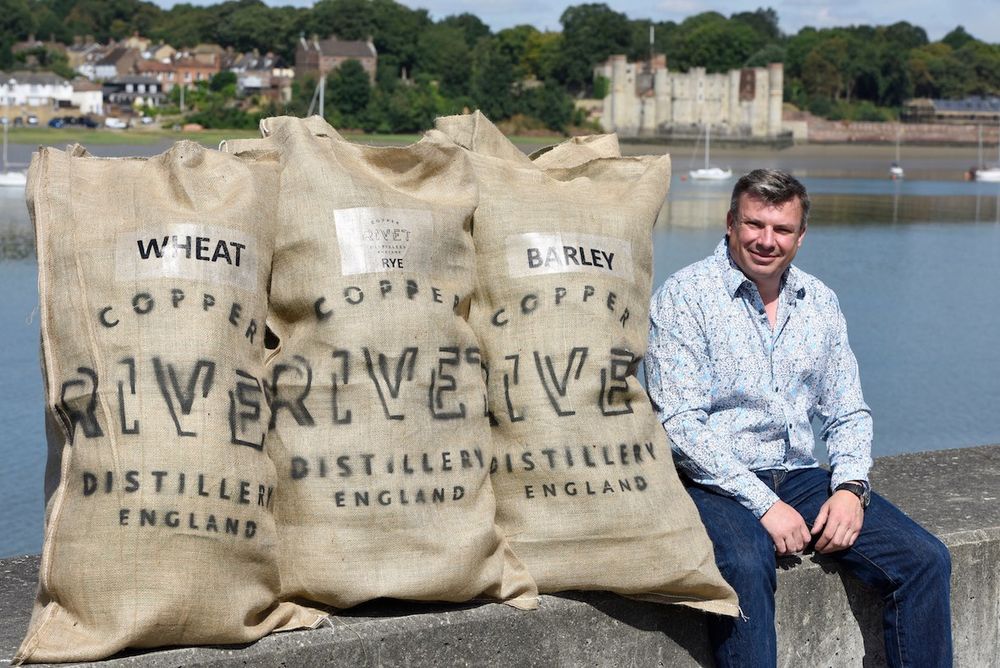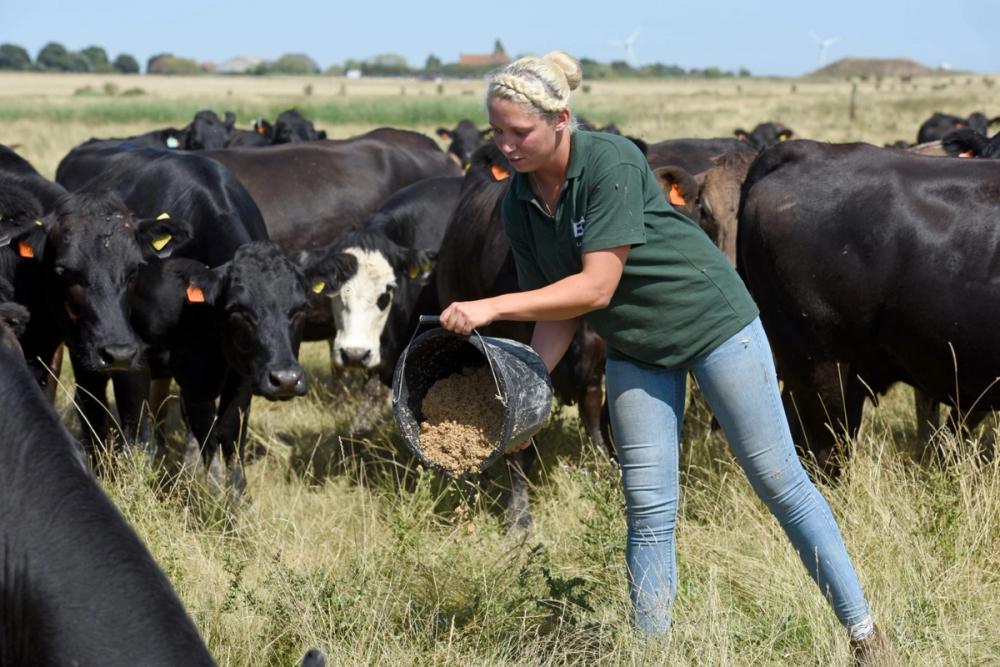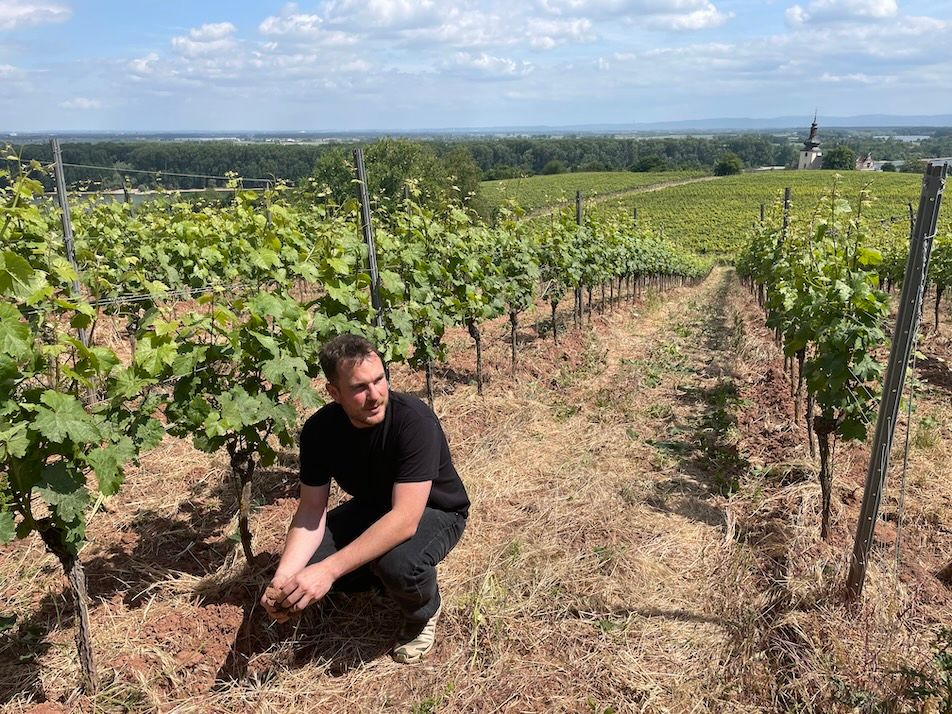“If we had just donned the straitjacket of the old world’s legacy rules, we would have missed the opportunity to explore the magical confluence of science, engineering and artistry that is the golden opportunity for English distilling,” says Russell.
As another Burns Night drifts past, some will have noticed a difference. While many will have toasted the auld haggis and its poet-cum-taxman with Scotch whisky, many of us – especially those south of Hadrian’s Wall – will have chosen something different. More and more drinkers are exploring whisky beyond the ‘traditional’ avenues of Scotch, Irish, American and Japanese. Things have moved on and Danish, French, German and Australian whiskies are coming into our field of vision, and my beloved ‘English’ too.
I believe 2022 could be a breakout year for English whisky.

Matthew Russell, Copper Rivet Distillery, with grain
When we first began making Masthouse Whisky at Copper Rivet Distillery near Chatham in Kent, people would ask me ‘why English whisky?’ Almost no-one asks this question now. And as England can harvest grain in abundance and has a warmer climate for the all-important maturation (especially in the South), then why not?
Remember when you first heard about English wine? People were amazed that it was ‘actually rather nice!’. We are approaching the point where the same conversations will begin to happen about English whisky, because there are a growing number of producers around the country and it’s infinitely more than “rather nice”.
In a spirits industry dominated by global corporations, which manufacture whisky in huge volumes, producers of English whisky are, by contrast, entrepreneurial whisky enthusiasts; and now, taking inspiration from best practices and great whisky products they’ve experienced globally, they are creating their own whiskies to the highest quality standards – in fascinating styles and with a cornucopia of delicious results.
The luck for England is that its producers have the latitude to produce solely with quality and flavour in mind. Scottish producers, for example, have Scotch Whisky Regulations which largely protect legacy techniques of the incumbent, multi-national owned distilleries. The bandwidth available to the English to use techniques from the best producers of the world (but also to develop their own) has the potential to make a massive contribution to the category – opening it to new consumers and re-invigorating the interest of long-time fans.

Abi Banik, head distiller, Copper Rivet Distillery
Like other English whisky distilleries, we have embraced this opportunity fully and use many different processes to create our whiskies. For example, our Masthouse Single Malt Whisky Double Pot Distilled is made just in the way of a Scotch single malt; but then alongside it we have Masthouse Single Malt Whisky Pot & Column Distilled – both made 100% at our distillery, using barley grown in a single field and from a single harvest. The malting, mashing, long fermentations, first distillations and the use of ex-Bourbon casks was the same for both, and the only thing which separates them is the second distillation which distinguishes them from one being a lighter aperitif and the other a digestif.
The combined use of our pot and column stills will be further showcased with the release this February 2022 of our new Masthouse Grain Whisky which is made with wheat, rye, raw barley and malted barley. If we had just donned the straitjacket of the old world’s legacy rules, we would have missed the opportunity to explore the magical confluence of science, engineering and artistry that is the golden opportunity for English distilling.
Now, I don’t believe in a Wild West, rule-free playing field for English distilleries. There must be a set of standards and rules which underpin quality; but we English distilleries have the opportunity to create rules which pinpoint quality control elements: These can allow room for creativity and innovation to add to flavour, quality and – ultimately – consumer enjoyment.
Indeed, such was our desire to ensure transparent and tough standards, in the absence of English whisky rules we even published a Charter to govern how Masthouse Whisky was to be made. These standards are super tight on quality points, such as grain provenance and where certain processes and maturation must take place; but they allow us scope to use different types of stills to create our whiskies’ flavours without having to rely on seasoned wood to create variety.
English Whisky rules will arrive and, when they do, we will very much welcome them.
Tapping into the importance of provenance

Cows on local farms are fed with spent grains.
Looking beyond the bottle, English whiskies are being established at a time when environmental and social concerns are factored into business plans: Luckily for us, we don’t have years of legacy to tidy up. A huge part of our mission at Copper Rivet Distillery is to strengthen the fabric of our community and to build a sustainable business that will last generations. This has meant being mindful of how we built our distillery, who we employ, our use of natural resources and our approach to waste.
Right from the outset, we wanted to create a whisky with some of the lowest food miles in the industry; so we grow our wheat, barley and rye in fields always less than 20 miles from the distillery, and we feed cows from those local farms with our spent grains. As well as those low food miles, this local sourcing creates high traceability of quality and flavour.
With our Masthouse Whiskies we take the localness even further by storing our barrels within a mile of the distillery so as to increase their potential ‘terroir’ and we bottle Masthouse Whiskies here at the distillery as well. Like our other English Whisky colleagues, we’ll continue to seek out ways to improve in this area; but, if consumers want to be comfortable their whisky is trying to embrace sustainability, English whisky is a safe place to be on so many fronts, particularly with its focus on grain provenance.
At the moment, there are probably ten English distilleries with mature whisky; but there are others busy maturing stock, and this will help the category gain momentum. One English whisky brand already has a national listing in a ‘big four’ grocer, another is well represented in airport Duty Free and others have regional listings in higher-end grocers.
Five-star hotels, top gastropubs and restaurants around the country are routinely adding English whisky to their lists – because the whisky tastes as good or better than some of the rather ‘distant’, traditional options. Importantly, customers want to be offered high quality local produce and English whisky is a regular feature in specialist clubs like the Summerton Whisky Club and the Boutique-y Whisky Company or in dedicated whisky clubs like ‘Exploring English Whisky’. Even TV is getting excited via features on weekend TV food shows.
The liquid output of the English Whisky ‘industry’ remains tiny, but it is growing, and more distilleries have whisky which will come of age this year. Those of us who already have mature stocks have been increasing the volumes available. English whisky will not be any threat to ‘traditional’ whiskies anytime soon – but I believe we will invigorate the market and that 2022 will be the year that English whisky breaks through.









































